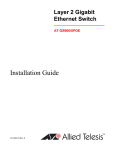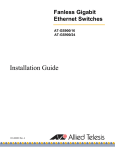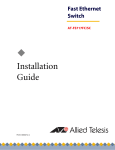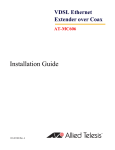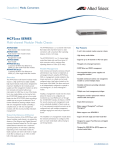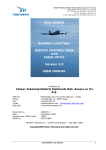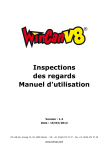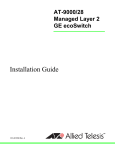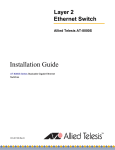Download Allied Telesis AT-FS708
Transcript
Fast Ethernet Switch AT-FS708 Installation Guide 613-001268 Rev. A Copyright © 2009 Allied Telesis, Inc. All rights reserved. No part of this publication may be reproduced without prior written permission from Allied Telesis, Inc. Allied Telesis is a trademark of Allied Telesis, Inc. Microsoft and Internet Explorer are registered trademarks of Microsoft Corporation. Netscape Navigator is a registered trademark of Netscape Communications Corporation. All other product names, company names, logos or other designations mentioned herein are trademarks or registered trademarks of their respective owners. Allied Telesis, Inc. reserves the right to make changes in specifications and other information contained in this document without prior written notice. The information provided herein is subject to change without notice. In no event shall Allied Telesis, Inc. be liable for any incidental, special, indirect, or consequential damages whatsoever, including but not limited to lost profits, arising out of or related to this manual or the information contained herein, even if Allied Telesis, Inc. has been advised of, known, or should have known, the possibility of such damages. Electrical Safety and Emissions Standards This product meets the following standards. U.S. Federal Communications Commission Declaration of Conformity Manufacturer Name: Allied Telesis, Inc. Declares that the product: Fast Ethernet Switch Model Number: AT-FS708 This product complies with FCC Part 15B, Class B Limits: This device complies with part 15 of the FCC Rules. Operation is subject to the following two conditions: (1) This device must not cause harmful interference, and (2) this device must accept any interference received, including interference that may cause undesired operation. Radiated Energy Note: This equipment has been tested and found to comply with the limits for a Class B digital device pursuant to Part 15 of FCC Rules. These limits are designed to provide reasonable protection against harmful interference in a residential installation. This equipment generates, uses and can radiate radio frequency energy and, if not installed and used in accordance with instructions, may cause harmful interference to radio or television reception, which can be determined by turning the equipment off and on. The user is encouraged to try to correct the interference by one or more of the following measures: - Reorient or relocate the receiving antenna. - Increase the separation between the equipment and the receiver. - Connect the equipment into an outlet on a circuit different from that to which the receiver is connected. - Consult the dealer or an experienced radio/TV technician for help. Changes and modifications not expressly approved by the manufacturer or registrant of this equipment can void your authority to operate this equipment under Federal Communications Commission rules. Industry Canada This Class B digital apparatus meets all requirements of the Canadian Interference-Causing Equipment Regulations. Cet appareil numérique de la classe B respecte toutes les exigences du Règlement sur le matériel brouilleur du Canada. EMI FCC Class B, CISPR 22 Class B, EN55022 Class B, C-TICK, CE Immunity EN55024 Electrical Safety UL 60950 (CULUS), EN60950 (TUV) 3 Translated Safety Statements Important: The indicates that a translation of the safety statement is available in a PDF document titled “Translated Safety Statements” on our web site. Go to http://www.alliedtelesis.com/support/software/. Select Switches under Product Category and this product under Product Name. You can view this document online or download it onto a local workstation or server. 4 Contents Preface ..................................................................................................................................................................................6 Safety Symbols Used in this Document..................................................................................................................................7 Where to Find Web-based Guides .........................................................................................................................................8 Contacting Allied Telesis ........................................................................................................................................................9 Online Support ................................................................................................................................................................9 Email and Telephone Support .........................................................................................................................................9 Warranty ..........................................................................................................................................................................9 Returning Products..........................................................................................................................................................9 Sales or Corporate Information .......................................................................................................................................9 Management Software Updates ......................................................................................................................................9 Chapter 1: Product Description ........................................................................................................................................10 Overview...............................................................................................................................................................................11 Key Features .................................................................................................................................................................12 Hardware Feature Description..............................................................................................................................................13 10/100Base-TX Twisted Pair Ports ...............................................................................................................................13 System and Port LEDs ..................................................................................................................................................14 ECOFriendly Push Button .............................................................................................................................................15 AC Power Connector.....................................................................................................................................................15 A Few Ethernet Switching Basics .........................................................................................................................................16 MAC Address Table ......................................................................................................................................................16 Duplex Mode .................................................................................................................................................................17 Store and Forward.........................................................................................................................................................17 Backpressure and Flow Control ....................................................................................................................................17 Chapter 2: Installation .......................................................................................................................................................19 Reviewing Safety Precautions ..............................................................................................................................................20 Selecting a Site for the Switch ..............................................................................................................................................22 Planning the Installation .......................................................................................................................................................23 Unpacking the Switch ...........................................................................................................................................................24 Installing the Switch on a Table or Desktop..........................................................................................................................25 Wall-Mounting the Switch .....................................................................................................................................................26 Installing the Switch in a Rack ..............................................................................................................................................28 Cabling the Switch ................................................................................................................................................................30 Powering On the Switch .......................................................................................................................................................31 Chapter 3: Troubleshooting ..............................................................................................................................................32 Appendix A: Technical Specifications .............................................................................................................................33 Physical Specifications .........................................................................................................................................................33 Environmental Specifications................................................................................................................................................33 Power Specifications ............................................................................................................................................................33 Safety and Electromagnetic Emissions Certifications...........................................................................................................34 RJ-45 Twisted Pair Port Connectors ....................................................................................................................................35 5 Preface This guide contains instructions on how to install the AT-FS708 Fast Ethernet switch. This preface contains the following sections: “Safety Symbols Used in this Document” on page 7 “Where to Find Web-based Guides” on page 8 “Contacting Allied Telesis” on page 9 6 AT-FS708 Fast Ethernet Switch Installation Guide Safety Symbols Used in this Document This document uses the safety symbols defined in Table 1. Table 1. Safety Symbols Symbol Meaning Description Caution Performing or omitting a specific action may result in equipment damage or loss of data. Warning Performing or omitting a specific action may result in electrical shock. 7 Preface Where to Find Web-based Guides The installation and user guides for all Allied Telesis products are available in portable document format (PDF) on our web site. Go to http://www.alliedtelesis.com/support/software/. Select Switches under Product Category and the this product under Product Name. You can view the documents online or download them onto a local workstation or server. 8 AT-FS708 Fast Ethernet Switch Installation Guide Contacting Allied Telesis This section provides Allied Telesis contact information for technical support as well as sales and corporate information. Online Support You can request technical support online by accessing the Allied Telesis Knowledge Base: www.alliedtelesis.com/support/kb.aspx. You can use the Knowledge Base to submit questions to our technical support staff and review answers to previously asked questions. Email and Telephone Support For Technical Support via email or telephone, refer to the Support & Services section of the Allied Telesis web site: www.alliedtelesis.com. Select your country from the list displayed on the website. then select the appropriate menu tab. Warranty For hardware warranty information, refer to the Allied Telesis web site: www.alliedtelesis.com/support/warranty. Returning Products Products for return or repair must first be assigned a return materials authorization (RMA) number. A product sent to Allied Telesis without an RMA number will be returned to the sender at the sender’s expense. To obtain an RMA number, contact the Allied Telesis Technical Support group at our web site: www.alliedtelesis.com/support/rma. Select your country from the list displayed on the website. Then select the appropriate menu tab. Sales or Corporate Information Management Software Updates You can contact Allied Telesis for sales or corporate information through our web site: www.alliedtelesis.com. To find the contact information for your country, select Contact Us -> Worldwide Contacts. New releases of management software for our managed products are available from either of the following Internet sites: Allied Telesis web site: www.alliedtelesis.com Allied Telesis FTP server: ftp://ftp.alliedtelesis.com If you prefer to download new software from the Allied Telesis FTP server from your workstation’s command prompt, you will need FTP client software and you must log in to the server. Enter “anonymous” for the user name and your email address for the password. 9 Chapter 1 Product Description This chapter contains the follows sections: “Overview” on page 11 “Key Features” on page 12 “Hardware Feature Description” on page 13 “A Few Ethernet Switching Basics” on page 16 10 AT-FS708 Fast Ethernet Switch Installation Guide Overview The AT-FS708 switch is an unmanaged eight-port Fast Ethernet switch. This switch offers a range of features and capabilities that can be used in a variety of network configurations and topologies, such as: Creating small workgroups with dedicated 10 Mbps and 100 Mbps links to your network devices, such as workstations, servers, printers, and routers. Interconnecting Ethernet hubs or switches to provide a bridge between the different workgroups of your network. Connecting to other Ethernet switches so that they can be part of a larger Ethernet network. Maximizing your existing network by providing full-duplex operation over a twisted pair port. Figure 1 illustrates the front panel of the AT-FS708 switch. AT-FS708 10Base-T/100Base-TX 8 Ports Fast Ethernet Switch POWER 1 2 3 4 5 6 7 8 LINK/ACT 100M FDX 1 2 3 4 5 6 7 8 AUTO MDI/MDI-X 1767 Figure 1. AT-FS708 Front Panel Figure 2 illustrates the back panel of the AT-FS708 switch. 100-240VAC~ 50-60Hz 991 Figure 2. AT-FS708 Back Panel The AT-FS708 switch can be used on a desktop, or mounted to a wall or in a rack. The switch is easy to install and does not require software configuration or management. 11 Chapter 1: Product Description Key Features The AT-FS708 switch has the following key features: Eight 10/100 Mbps (10Base-T / 100Base-TX) twisted pair ports with RJ-45 connectors System and port LEDs Auto-Negotiate and Auto MDI/MDI-X on all 10/100 Mbps twisted pair ports Support half- or full-duplex mode on all 10/100 Mbps twisted pair ports Auto-Negotiation (IEEE 802.3u-compliant) Flow control (IEEE 802.3x-compliant) Storage up to 1K MAC addresses Product support 1536 bytes frame size. For use on a desktop, on a wall, or in a rack Support Green Ethernet including Link-On, Cable Length, and LinkDown power savings ECO-Friendly: LED can be forced to switch off with push button RoHS Compliant 12 AT-FS708 Fast Ethernet Switch Installation Guide Hardware Feature Description The sections below describe the hardware features of the AT-FS708 Fast Ethernet switch: 10/100Base-TX Twisted Pair Ports “10/100Base-TX Twisted Pair Ports,” next “System and Port LEDs” on page 14 “ECOFriendly Push Button” on page 15 “AC Power Connector” on page 15 The AT-FS708 Fast Ethernet switch features eight twisted pair ports. The features of the twisted pair ports are explained in the following sections. Type of Connector All twisted pair ports feature 8-pin RJ-45 connectors. (For the port pinouts, refer to “RJ-45 Twisted Pair Port Connectors” on page 35.) Speed The ports are 10Base-T, and 100Base-T compliant and are capable of 10 Mbps and 100 Mbps speeds. The ports are IEEE 802.3u Auto-Negotiation compliant. With Auto-Negotiation, the switch automatically matches the highest possible common speed between each switch port and each endnode. For example, if an end-node is capable of only 10 Mbps, the switch sets the port connected to the end-node to 10 Mbps. Duplex Mode Each twisted pair port on the switch can operate in either half- or fullduplex mode. The twisted pair ports are IEEE 802.3u-compliant and will Auto-Negotiate the duplex mode setting. Note In order for the switch to set the duplex mode for each port correctly, the end-nodes that you connect to the switch ports also need to be configured for Auto-Negotiation. Otherwise, a duplex mode mismatch can occur, affecting network performance. For further information, refer to “Duplex Mode” on page 17. Type of Cabling 13 Chapter 1: Product Description For 10 Mbps operation, Category 3 or better 100 ohm shielded or unshielded twisted pair cabling is required. For 100 Mbps operation, Category 5 and Enhanced Category 5 (5E) 100 ohm shielded or unshielded twisted pair cabling is required. Maximum Distance Each twisted pair port has a maximum operating distance of 100 meters (328 feet). Auto MDI/MDI-X All of the twisted pair ports on the switch are auto-MDI and IEEE 802.3abcompatible. The ports use the auto-MDI feature to automatically configure themselves as MDI or MDI-X when connected to an end-node. Consequently, you can use a straight-through twisted pair cable to connect any network device to a port. System and Port LEDs The system and port LEDs on the front panel of the AT-FS708 switch display status information. Each port has three LEDs. Table 2 describes the system and port LEDs on the AT-FS708 Fast Ethernet switch. Table 2. System and Port LEDs LED POWER LINK/ACT 100M FDX State Description Green The switch is powered ON and operating normally. OFF The switch is not receiving power. Green A valid link is established on the port. Blinking Green Frames are being transmitted/received on the port. OFF No link is established on the port. Green The port is operating at a speed of 100 Mbps. OFF The port is operating at a speed of 10 Mbps. Green The port is operating in full-duplex mode. OFF The port is operating in half-duplex mode. 14 AT-FS708 Fast Ethernet Switch Installation Guide ECOFriendly Push Button The ecoFriendly switch on the front panel may be used to turn ON or OFF the port LEDs. Select the OFF position for power conservation. The power LED remains active at all times. Note The power LED remains active at all times. AC Power Connector The AT-FS708 Fast Ethernet switch has a single AC power supply socket on the back panel. Refer to Appendix A, “Technical Specifications” on page 33, for the input voltage range. To power ON or OFF the switch, connect or disconnect the power cord. 15 Chapter 1: Product Description A Few Ethernet Switching Basics An Ethernet switch interconnects network devices, such as workstations, printers, routers, and other Ethernet switches, so that they can communicate with each other by sending and receiving Ethernet frames. MAC Address Table Every hardware device on your network has a unique MAC address. This address is assigned to the device by the device’s manufacturer. For example, when you install a Network Interface Card (NIC) in a computer so that you can connect it to the network, the NIC already has a MAC address assigned to it by its manufacturer. The AT-FS708 Fast Ethernet switch can contain up to 1,024 entries in its MAC address table. The switch uses the table to store the MAC addresses of the network end-nodes connected to the ports, along with the port number on which each address was learned. A switch learns the MAC addresses of the end-nodes by examining the source address of each packet received on a port. It adds the address and port on which the packet was received to the MAC table if the address had not already been entered in the table. The result is a table that contains all the MAC addresses of the devices that are connected to the switch’s ports, and the port number where each address was learned. When the switch receives a packet, it also examines the destination address and, by referring to its MAC address table, determines the port on which the destination end-node is connected. It then forwards the packet to the appropriate port and on to the end-node. This increases network bandwidth by limiting each frame to the appropriate port when the intended end-node is located, freeing the other switch ports for receiving and transmitting data. If the switch receives a packet with a destination address that is not in the MAC address table, it floods the packet to all the ports on the switch. If the ports have been grouped into virtual LANs, the switch floods the packet only to those ports which belong to the same VLAN as the port on which the packet was received. This prevents packets from being forwarded into inappropriate LAN segments, increasing network security. When the destination end-node responds, the switch adds its MAC address and port number to the table. If the switch receives a packet with a destination address that is on the same port on which the packet was received, it discards the packet without forwarding it on to any port. Since both the source end-node and the destination end-node for the packet are located on the same port on the switch, there is no reason for the switch to forward the packet. 16 AT-FS708 Fast Ethernet Switch Installation Guide Duplex Mode Duplex mode refers to how an end node receives and transmits data. If an end node can receive or transmit data, but not both simultaneously, it is operating in what is referred to as half-duplex mode. If an end node can both receive and transmit data simultaneously, the end node is operating in full-duplex mode. Naturally, an end node capable of operating in fullduplex can handle data much faster than an end node that can only operate in half-duplex mode. The twisted pair ports on the AT-FS708 switch can operate in half- or fullduplex mode for 10/100 Mbps. They are IEEE 802.3u-compliant and use Auto-Negotiation to set the duplex mode setting for you automatically. Note In order for a switch port to successfully Auto-Negotiate its duplex mode with a 10 or 100 Mbps end-node, the end-node should also be configured for Auto-Negotiation. Otherwise, a duplex mode mismatch can occur. A switch port using Auto-Negotiation defaults to half-duplex if it detects that the end-node is not using AutoNegotiation. This results in a mismatch if the end-node is operating at a fixed duplex mode of full-duplex. Store and Forward An AT-FS708 switch uses store and forward as the method for receiving and transmitting frames. When a Ethernet frame is received on a switch port, the switch does not retransmit the frame out the destination port until it has received the entire frame and stored the frame in a port buffer. It then examines the frame to determine if it is a valid frame. Invalid frames, such as fragments or runts, are discarded by the switch. This insures that only valid frames are transmitted out the switch ports and that damaged frames are not propagated on your network. Backpressure and Flow Control To maintain the orderly movement of data between the end-nodes, an Ethernet switch may periodically need to signal an end-node to stop sending data. This can occur under several circumstances. For example, if two end-nodes are operating at different speeds, the switch, while transferring data between the end-nodes, might need to instruct the faster end-node to stop transmitting data to allow the slower end-node to catch up. An example of this would be when a server operating at 100 Mbps is sending data to a workstation operating at only 10 Mbps. How a switch signals an end-node to stop transmitting data differs depending on the duplex mode of the end-node and switch port. A twisted pair port operating in half-duplex mode stops an end-node from transmitting data by forcing a collision. A collision on an Ethernet network occurs when two end-nodes attempt to transmit data using the same data link at the same time. A collision causes an end-node to stop sending data, wait for a brief period of time, and then retransmit the same data. Once the switch is ready to receive data again, the switch stops forcing collisions. This is referred to as backpressure. 17 Chapter 1: Product Description A port operating in full-duplex mode uses PAUSE frames, as specified in the IEEE 802.3x standard, to stop the transmission of data from an endnode. Whenever the switch wants an end-node to stop transmitting data, it issues this frame. The frame instructs the end-node to cease transmission for a period of time specified within the frame. The switch continues to issue PAUSE frames until it is ready again to receive data from the endnode. This is referred to as flow control. 18 Chapter 2 Installation This chapter contains the following sections: “Reviewing Safety Precautions” on page 20 “Selecting a Site for the Switch” on page 22 “Planning the Installation” on page 23 “Unpacking the Switch” on page 24 “Installing the Switch on a Table or Desktop” on page 25 “Wall-Mounting the Switch” on page 26 “Installing the Switch in a Rack” on page 28 “Cabling the Switch” on page 30 “Powering On the Switch” on page 31 19 Chapter 2: Installation Reviewing Safety Precautions Please review the following safety precautions before you begin to install the switch. Note Important: The indicates that a translation of the safety statement is available in a PDF document titled “Translated Safety Statements” on our web site. Go to http://www.alliedtelesis.com/support/software/. Select Switches under Product Category and this product under Product Name. You can view this document online or download it onto a local workstation or server. Warning: To prevent electric shock, do not remove the cover. No user-serviceable parts inside. This unit contains hazardous voltages and should only be opened by a trained and qualified technician. To avoid the possibility of electric shock, disconnect electric power to the product before connecting or disconnecting the LAN cables. E1 Warning: Do not work on equipment or cables during periods of lightning activity. E2 Warning: Power cord is used as a disconnection device. To deenergize equipment, disconnect the power cord. E3 Warning: Class I Equipment. This equipment must be earthed. The power plug must be connected to a properly wired earth ground socket outlet. An improperly wired socket outlet could place hazardous voltages on accessible metal parts. E4 Pluggable Equipment. The socket outlet shall be installed near the equipment and shall be easily accessible. E5 Caution: Air vents must not be blocked and must have free access to the room ambient air for cooling. E6 Warning: Operating Temperature. This product is designed for a maximum ambient temperature of 40° degrees C. E7 20 AT-FS708 Fast Ethernet Switch Installation Guide All Countries: Install product in accordance with local and National Electrical Codes. E8 Warning: As a safety precaution, install a circuit breaker with a minimum value of 15 Amps between the equipment and the DC power source. Always connect the wires to the LAN equipment first before you connect the wires to the circuit breaker. Do not work with HOT feeds to avoid the danger of physical injury from electrical shock. Always be sure that the circuit breaker is in the OFF position before connecting the wires to the breaker. E9 Caution: The attached mounting brackets must be used to securely mount the device on the wall. E15 Circuit Overloading: Consideration should be given to the connection of the equipment to the supply circuit and the effect that overloading of circuits might have on over current protection and supply wiring. Appropriate consideration of equipment nameplate ratings should be used when addressing this concern. E21 Warning: Mounting of the equipment in the rack should be such that a hazardous condition is not created due to uneven mechanical loading. E25 If installed in a closed or multi-unit rack assembly, the operating ambient temperature of the rack environment may be greater than the room ambient temperature. Therefore, consideration should be given to installing the equipment in an environment compatible with the manufacturer’s maximum rated ambient temperature (Tmra). E35 Caution: Installation of the equipment in a rack should be such that the amount of air flow required for safe operation of the equipment is not compromised. E36 Warning: Reliable earthing of rack-mounted equipment should be maintained. Particular attention should be given to supply connections other than direct connections to the branch circuits (e.g., use of power strips). E37 21 Chapter 2: Installation Selecting a Site for the Switch Observe the following requirements when choosing a site for the AT-FS708 Fast Ethernet switch: If you plan to install the switch in an equipment rack, be sure that the rack is safely secured and that it will not tip over. Devices in a rack should be installed starting at the bottom, with the heavier devices near the bottom of the rack. If you are installing the switch on a table, be sure that the table is level and secure. The power outlet for the switch should be located near the unit and should be easily accessible. The site should provide for easy access to the ports on the front of the switch. This will make it easy for you to connect and disconnect cables, as well as view the switch’s LEDs. To allow proper cooling of the switch, air flow around the unit and through its vents on the side and rear should not be restricted. Do not place objects on top of the switch. Do not expose the switch to moisture or water. Ensure that the site is a dust-free environment. Use dedicated power circuits or power conditioners to supply reliable electrical power to the network devices. 22 AT-FS708 Fast Ethernet Switch Installation Guide Planning the Installation Table 3 contains the cabling specifications for the twisted pair ports. Table 3. Twisted Pair Cabling and Distances Speed Type of Cable Maximum Operating Distance 10 Mbps Category 3 or better 100-ohm shielded or unshielded twisted pair cable 100 m (328 ft) 100 Mbps Category 5 or Category 5E (Enhanced) 100-ohm shielded or unshielded twisted pair cable 100 m (328 ft) Note The twisted pair ports on the switch feature Auto-MDI when operating at either 10 or 100 Mbps. Each port is individually configured as MDI or MDI-X when connected to an end-node. Consequently, you can use a straight-through twisted pair cable when connecting any network device to a twisted pair port on the switch. A port operating at 10 or 100 Mbps uses four of the eight strands in twisted pair wiring. 23 Chapter 2: Installation Unpacking the Switch To unpack an AT-FS708 switch, perform the following procedure: 1. Remove all components from the shipping package. Note Store the packaging material in a safe location. You must use the original shipping material if you need to return the unit to Allied Telesis. 2. Place the switch on a level, secure surface. 3. Verify that the following hardware components are included in your switch package. If any item is missing or damaged, contact your Allied Telesis sales representative for assistance. One AT-FS708 Fast Ethernet switch Rubber Feet for desktop installation Wall mount kits Rack mount kits AC power cord 24 AT-FS708 Fast Ethernet Switch Installation Guide Installing the Switch on a Table or Desktop To install the switch on a table or desktop, perform the following procedure: 1. Remove all the items from the packaging and store the packaging material in a safe place. In the event a problem occurs and you need to return the unit, please use as much of the original shipping material as possible. 2. Attach the four self-adhesive rubber feet to the bottom of the switch, as shown in Figure 3. AUTO MDI/MDI-X 1 2 3 4 5 6 7 8 FDX 100M 10Base-T/100Base-TX 8 Ports Fast Ethernet Switch AT-FS708 LINK/ACT POWER 1 2 3 4 5 6 7 8 1769 Figure 3. Attaching the Rubber Feet 3. Place the switch on a flat and secure surface, leaving ample space around the switch for ventilation. 4. Proceed to “Cabling the Switch” on page 30 for the cable installation. 25 Chapter 2: Installation Wall-Mounting the Switch The switch can be mounted vertically on a wall using the mounting brackets that come with the unit. The wall-mounting screws and plastic anchors necessary to mount the switch on a wall are provided. Note The plastic anchors used for wall mounting the switch are intended for installation in walls made of sheetrock or concrete materials. To mount an AT-FS708 switch onto a wall, perform the following procedure: 1. Remove all equipment from the package and store the packaging material in a safe place. 2. If attached, remove the rubber feet, data cables, and power cord from the switch. 3. Select a wall location for the switch. 4. Mark locations for two holes 10.00 cm (3.94 in) apart on the wall as shown in Figure 4.. 10.00cm (3.94in) Figure 4. Wall Mounting Hole Dimensions 5. At the marked locations for the holes, drill the holes for the anchors.Each hole must be 0.635 mm (0.25 in) in diameter. 6. Install the two anchors and then the two screws. 26 AT-FS708 Fast Ethernet Switch Installation Guide 7. Align the switch horizontally. And then position and hang the switch onto the wall using the two keyhole slots located in the bottom of the switch, as illustrated in Figure 5. 8 7 6 5 4 3 2 AUTO MDI/M DI-X 1 ER POW /ACT LINK 8 -TX 8 S7-T0/100Baet seSwitch AT10-F Base Ethern 100M FDX 1 2 3 4 5 6 7 8 Ports Fast 1777 Figure 5. Aligning an AT-FS708 for Wallmount Installation 8. Make sure that the switch is securely mounted onto the wall. 9. Proceed to “Cabling the Switch” on page 30 for the cable installation. 27 Chapter 2: Installation Installing the Switch in a Rack Perform the following procedure to install the switch in a standard 19-inch rack. 1. If attached, remove the rubber feet, data cables, and power cord from the switch. 2. Attach the two mounting brackets (provided) to the sides of the switch using the bracket mounting screws (provided), as shown in Figure 6. AT-F S 708 10Ba Fast se-T/10 Ethe 0Bas rnet e-T Switc X 8 h Ports POWE R LINK/A CT 100M FDX 1 1 2 3 4 2 5 6 7 3 8 4 5 6 7 AUTO MDI/M 8 DI-X 1775 Figure 6. Attaching Brackets for Rack Mounting 28 AT-FS708 Fast Ethernet Switch Installation Guide 3. Mount the switch in a 19-inch rack using rack mounting screws (not provided), as shown in Figure 7. AT-F S 708 10Ba Fast se-T/10 Ethe 0Bas rnet e-T Switc X 8 Ports h POWE R LINK/A CT 100M FDX 1 1 2 3 4 2 5 6 7 3 8 4 5 6 7 AUTO MDI/M 8 DI-X 1776 Figure 7. Rack Mounting the Switch 4. Proceed to “Cabling the Switch” on page 30 for the cable installation. 29 Chapter 2: Installation Cabling the Switch To connect the twisted pair cables to the ports on the AT-FS708 switch, perform the following procedure: 1. Connect the twisted pair data cables to the RJ-45 ports on the switch, as shown in Figure 8. 1 2 3 4 5 6 7 AUT OM DI/M 8 DI-X 1774 Figure 8. Connecting the Twisted Pair Data Cables When connecting a twisted pair cable to a port, observe the following guidelines: An RJ-45 connector should fit snugly into the port on the switch. The tab on the connector should lock the connector into place. The ports on the switch are auto-MDI/MDI-X. You can use a straight-through twisted pair cable to connect any type of network device to a port on the switch. The network should not contain data loops, which can adversely affect network performance. A data loop exists when two or more network devices can communicate with each other over more than one data path. 30 AT-FS708 Fast Ethernet Switch Installation Guide Powering On the Switch To apply power to the AT-FS708 switch without the optional power cord retaining clip installed, perform the following procedure: 1. Apply AC power to the switch by plugging the power cord into the AC power connector on the back panel of the unit, as shown in Figure 9. Warning Power cord is used as a disconnection device: To de-energize equipment, disconnect the power cord. 5 Caution Use only safety licensed power supply cord. 100-2 40VA C~ 5 0 -60H z 989 Figure 9. Connecting the AC Power Connector to Switch 2. Plug the other end or the power cord into a wall outlet. 3. Verify that the POWER LED is green. If the LED is OFF, refer to “Troubleshooting” on page 32. 4. Power ON the end-nodes connected to the switch. 5. Check that all the LINK/ACT LEDs are green. If any of the LEDs is OFF, refer to “Troubleshooting” on page 32 for instructions. The switch is ready for network operations. 31 Chapter 3 Troubleshooting This chapter contains information on how to troubleshoot the switch in the event a problem occurs. Note If you are still unable to resolve the problem after following the instructions in this chapter, contact Allied Telesis Technical Support for assistance. Refer to “Contacting Allied Telesis” on page 9. Check the POWER LED on the front of the switch. If the LED is OFF, indicating that the unit is not receiving power, do the following: Verify that the power cord is securely connected to the power source and to the AC connector on the back panel of the switch. Verify that the power outlet has power by connecting another device to it. Try connecting the unit to another power source. Try using a different power cord. Verify that the voltage from the power source is within the required levels for your region. Verify that the LINK/ACT LED for each port is ON. If a LINK/ACT LED is OFF, do the following: Verify that the end-node connected to the port is powered ON and is operating properly. Verify that the twisted pair cable is securely connected to the port on the switch and to the port on the end-node. Ensure that the twisted pair cable does not exceed 100 meters (328 feet). Verify that you are using the appropriate category of twisted pair cable: Category 3 or better for 10 Mbps operation and Category 5 and Category 5E for 100 Mbps operation. 32 Appendix A Technical Specifications Physical Specifications Dimensions: (W x D x H) 250 mm x 117 mm x 36.5 mm (9.84 in x 4.60 in x 1.44 in) Weight: 0.75 kg (1.65 lbs) Environmental Specifications Operating Temperature: 0° C to 40° C (32° F to 104° F) Storage Temperature: -25° C to 70° C (-13° F to 158° F) Operating Humidity: 5% to 90% non-condensing Storage Humidity: 5% to 95% non-condensing Operating Altitude Range: Up to 10,000 feet (3,048 meters) MTBF: 390,000 hours Power Specifications Power Consumption: 4.7 watts maximum AC Input Electrical Ratings: AC 100~240 VAC Frequency: 50/60 Hz Rated Output: 3.3V / 2A 33 Appendix A: Technical Specifications Safety and Electromagnetic Emissions Certifications EMI FCC Part 15 Class B, CISPR 22 Class B, EN55022 Class B, Immunity EN55024 Electrical Safety UL 60950 (CULUS), EN60950 (TUV), C-Tick, CE Mark 34 AT-FS708 Fast Ethernet Switch Installation Guide RJ-45 Twisted Pair Port Connectors This section lists the connectors and connector pinouts for the AT-FS708 Fast Ethernet switch and its components. Figure 10 illustrates the pin layout to an RJ-45 connector and port. 1 8 8 1 Figure 10. RJ-45 Connector and Port Pin Layout Table 4 lists the RJ-45 pin signals when a twisted pair port is operating in the MDI configuration. Table 4. MDI Pin Signals (10Base-T or 100Base-TX) Pin Signal 1 TX+ 2 TX- 3 RX+ 6 RX- Table 5 lists the RJ-45 port pin signals when a twisted pair port is operating in the MDI-X configuration. Table 5. MDI-X Pin Signals (10Base-T or 100Base-TX) Pin Signal 1 RX+ 2 RX- 3 TX+ 6 TX- 35



































